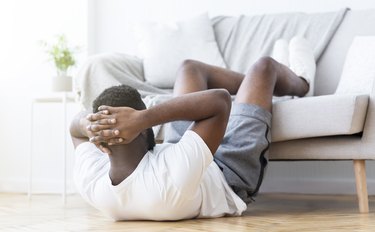
Sore in your neck (and not your abs) after a core workout? Neck strain during abs-focused exercises is so common, you might think it's just a fact of life. But we're here to tell you — you don't have to struggle with a nagging neck ache every time you do bicycle crunches.
On the contrary, neck discomfort is a sign that something isn't quite right and needs an adjustment. Here, K. Aleisha Fetters, CSCS, author of Fitness Hacks for Over 50, explains what may be causing your annoying aches during your ab workouts, plus offers tweaks for your core moves, so they're more effective and stop being a pain in the neck.
Video of the Day
Video of the Day
Problem 1: Your Neck Is Compensating for Your Abs
"When we hit our end range of movement in one joint, a nearby one makes up for it by doing overtime," Fetters says. Though this holds true throughout the entire body, it's especially common during exercises like crunches.
"When people hit their end range of spinal flexion — either because that's just how far their spine bends or because the rectus abdominis is fatigued — we often use the muscles in the front of the spine to help us move just a little bit farther," Fetters says.
In other words, our neck compensates for our abs and attempts to lift our head higher off the ground.
Fix It
“Keeping your chin tucked results in less activation of the sternocleidomastoid muscle, which runs along the front and sides of the neck,” Fetters says. “A chin-tucked position shortens the lever acting on the head to reduce how hard your neck muscles have to work to keep you in neutral alignment.”
If that’s hard to picture, Fetters says think about gripping a lollipop at the base of the stick. Holding it just beneath the candy makes it feel lighter, right? It’s the same concept at work with your neck muscles.
Not only will tucking your chin decrease neck distress, it'll also result in greater rectus abdominis and external oblique activation, thus increasing the effectiveness of your exercise, says Fetters, citing a small January 2016 study in the Journal of Physical Therapy Science.
Problem 2: Your Technique or Form Needs Work
Oftentimes, you can chalk up your neck crick to improper form. During crunches and sit-ups, many "people just pull their body up, leading with the front of their cervical spine, so their neck, as opposed to their core, leads the parade," Fetters says.
That may be old news to you. But poor posture — and resulting neck pain — happens in ab moves you might not expect, like planks. "A lot of people jut their neck up to look around the room or let their head hang — either scenario will put the muscles of the neck to work," she says.
Fix It
For crunches and sit-ups, Fetters suggests cradling your head with your hands (place your fingertips behind your ears, not on your neck). The trick is to support the weight of your head without pulling with your hands. To do that, “keep a light touch and really focus on pulling with your anterior core,” she says.
With planks, “the goal is to keep your cervical spine as a neutral continuation of the rest of your spine,” Fetters says. "Just as your head sits in line with your torso and legs when standing, it should be in line with the rest of your body when in a plank."
Problem 3: Gravity Is Pulling on Your Neck
"When standing, gravity keeps the head stacked on top of the neck," Fetter says. Conversely, in positions like a Russian twist, V-up, plank or side plank, gravity does the opposite. In fact, "it's working to force your head out of neutral alignment," she says.
And when it comes to gravity's pull, it doesn't help that our heads are heavy. "The average noggin weighs 10 to 11 pounds and, oftentimes, when performing core flexion exercises, exercisers feel that full weight, plus some," Fetters says.
When your hefty head isn't sitting stacked on your neck in perfect alignment, it puts a ton of extra weight and pressure on your spine. Case in point: "text neck." The term refers to the way we bend our necks down as we use our cell phones. Believe it or not, this poor posture and position of the head significantly increases the load on your spine.
For instance, when you bend your head at a 60-degree angle, you put approximately 60 pounds of stress on your cervical spine, according to Fetters, citing a November 2014 study in Surgical Technology International. That's why neutral neck alignment during ab exercises is major for minimizing pain and discomfort and slashing stress on your spine.
Fix It
“If you have ongoing neck issues, I'd recommend scrapping core flexion exercises for standing and supine exercises,” Fetters says. Since your neck doesn’t need to fight gravity in these positions, it doesn’t have to work overtime and put undue stress on those muscles.
“Any standing or supine core exercises, such as wood chops, medicine ball throws, dead bugs or hollow-body holds with your head on the floor require little to no neck effort,” she says.
Was this article helpful?
150 Characters Max
0/150
Thank you for sharing!
Thank you for your feedback!